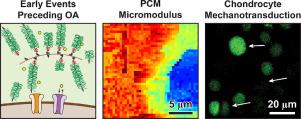Acta Biomaterialia ( IF 9.4 ) Pub Date : 2020-05-16 , DOI: 10.1016/j.actbio.2020.05.005 Daphney R Chery 1 , Biao Han 1 , Qing Li 1 , Ying Zhou 2 , Su-Jin Heo 3 , Bryan Kwok 1 , Prashant Chandrasekaran 1 , Chao Wang 1 , Ling Qin 4 , X Lucas Lu 5 , Dehan Kong 2 , Motomi Enomoto-Iwamoto 6 , Robert L Mauck 3 , Lin Han 1

|
The pericellular matrix (PCM) of cartilage is a structurally distinctive microdomain surrounding each chondrocyte, and is pivotal to cell homeostasis and cell-matrix interactions in healthy tissue. This study queried if the PCM is the initiation point for disease or a casualty of more widespread matrix degeneration. To address this question, we queried the mechanical properties of the PCM and chondrocyte mechanoresponsivity with the development of post-traumatic osteoarthritis (PTOA). To do so, we integrated Kawamoto's film-assisted cryo-sectioning with immunofluorescence-guided AFM nanomechanical mapping, and quantified the microscale modulus of murine cartilage PCM and further-removed extracellular matrix. Using the destabilization of the medial meniscus (DMM) murine model of PTOA, we show that decreases in PCM micromechanics are apparent as early as 3 days after injury, and that this precedes changes in the bulk ECM properties and overt indications of cartilage damage. We also show that, as a consequence of altered PCM properties, calcium mobilization by chondrocytes in response to mechanical challenge (hypo-osmotic stress) is significantly disrupted. These aberrant changes in chondrocyte micromechanobiology as a consequence of DMM could be partially blocked by early inhibition of PCM remodeling. Collectively, these results suggest that changes in PCM micromechanobiology are leading indicators of the initiation of PTOA, and that disease originates in the cartilage PCM. This insight will direct the development of early detection methods, as well as small molecule-based therapies that can stop early aberrant remodeling in this critical cartilage microdomain to slow or reverse disease progression.
Statement of Significance
Post-traumatic osteoarthritis (PTOA) is one prevalent musculoskeletal disease that afflicts young adults, and there are no effective strategies for early detection or intervention. This study identifies that the reduction of cartilage pericellular matrix (PCM) micromodulus is one of the earliest events in the initiation of PTOA, which, in turn, impairs the mechanosensitive activities of chondrocytes, contributing to the vicious loop of cartilage degeneration. Rescuing the integrity of PCM has the potential to restore normal chondrocyte mechanosensitive homeostasis and to prevent further degradation of cartilage. Our findings enable the development of early OA detection methods targeting changes in the PCM, and treatment strategies that can stop early aberrant remodeling in this critical microdomain to slow or reverse disease progression.
中文翻译:

软骨细胞周围基质微力学生物学的早期变化预示着创伤后骨关节炎的发作。
软骨的细胞周围基质(PCM)是围绕每个软骨细胞的结构独特的微区,并且对于健康组织中的细胞稳态和细胞-基质相互作用至关重要。这项研究询问PCM是疾病的起因还是更广泛的基质变性的受害者。为了解决这个问题,我们随着创伤后骨关节炎(PTOA)的发展询问了PCM和软骨细胞的机械反应性的机械特性。为此,我们将Kawamoto的膜辅助冷冻切片与免疫荧光引导的AFM纳米机械制图相结合,并量化了鼠软骨PCM和进一步去除的细胞外基质的微尺度模量。使用PTOA内侧半月板(DMM)小鼠模型的失稳,我们表明,PCM微力学的下降早在受伤后3天就很明显,而且这是在体ECM特性变化和明显的软骨损伤之前。我们还显示,由于PCM特性的改变,软骨细胞响应机械性挑战(低渗压力)而动员的钙明显受到破坏。这些由于DMM导致的软骨细胞微力学生物学异常变化可能会由于PCM重构的早期抑制而被部分阻止。总的来说,这些结果表明,PCM微力学生物学的改变是PTOA起始的主要指标,并且疾病起源于软骨PCM。这种见识将指导早期检测方法的发展,
重要声明
创伤后骨关节炎(PTOA)是一种折磨年轻人的流行肌肉骨骼疾病,目前尚无有效的早期发现或干预策略。这项研究表明,减少软骨周细胞基质(PCM)是PTOA引发的最早事件之一,而这反过来会损害软骨细胞的机械敏感性活动,从而导致软骨变性的恶性循环。挽救PCM的完整性有可能恢复正常的软骨细胞机械敏感稳态,并防止软骨进一步退化。我们的发现使针对PCM变化的早期OA检测方法得以开发,并能够在该关键微域中阻止早期异常重塑以减缓或逆转疾病进展的治疗策略。











































 京公网安备 11010802027423号
京公网安备 11010802027423号